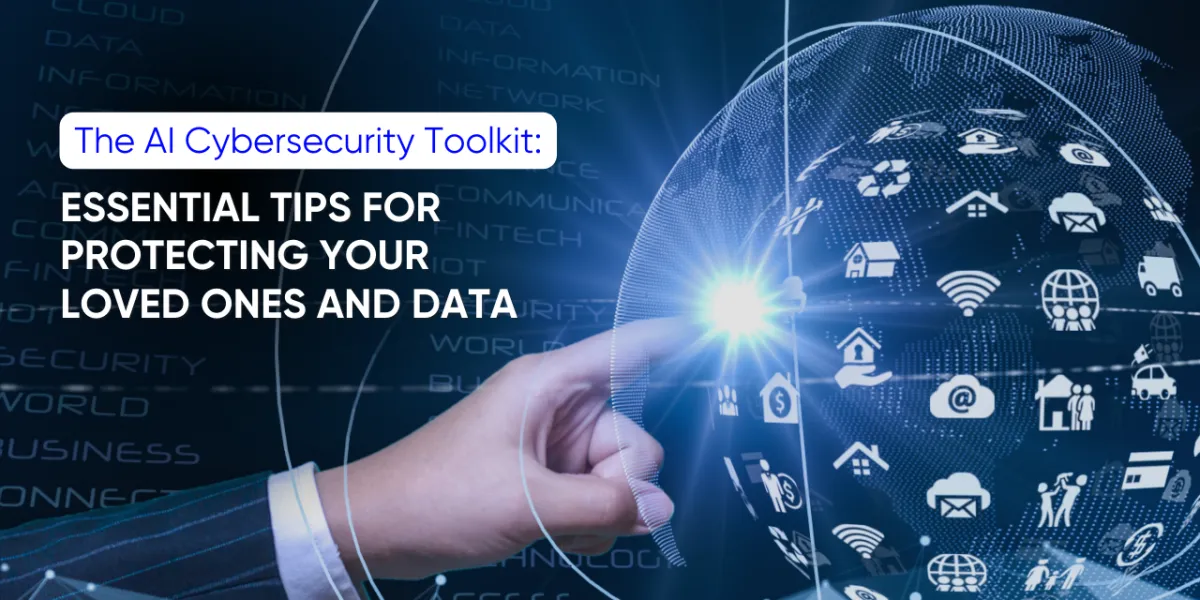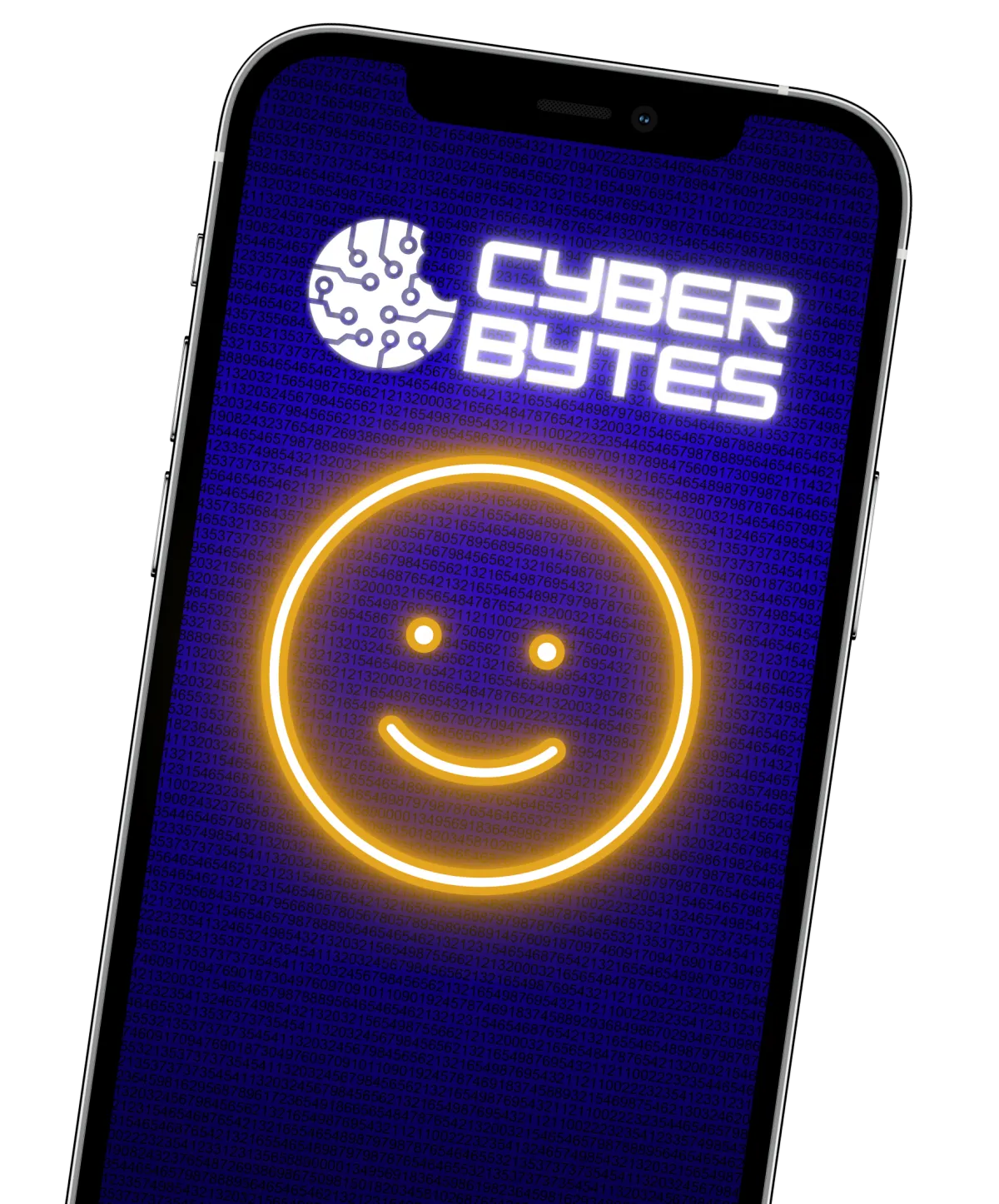You are what you click!
Learn how to make cybersecurity your way of life in an easy and guided way.
You are what you click!
Become Cyber savvy
EXPLORE BLOG BELOW
You are what you click!
Become Cyber savvy
You are what you click!
Become Cyber savvy
You are what you click!
Become Cyber savvy

The AI Cybersecurity Toolkit: Essential Tips for Protecting Your Loved Ones and Data
The AI Cybersecurity Toolkit: Essential Tips for Protecting Your Loved Ones and Data
Imagine this: You're sitting at your kitchen table, enjoying a quiet evening with your family. Suddenly, your phone buzzes with an email notification. It’s from your bank, alerting you to a suspicious login attempt. Your heart races as you realize the email looks legitimate but something feels off. This is a scenario many of us dread, yet it’s becoming increasingly common in our AI-driven world.
Welcome to the world of AI in cybersecurity, where artificial intelligence is both a powerful ally and a cunning adversary. As we navigate this landscape, it’s essential to be intentional, aware, and mindful—what I call the Be I AM principle. In this blog, we’ll explore how AI impacts cybersecurity, the threats it poses, and how you can protect your loved ones and data with practical, actionable steps.
Understanding AI in Cybersecurity
What is AI in Cybersecurity?
Artificial Intelligence (AI) refers to the simulation of human intelligence processes by machines, especially computer systems. These processes include learning, reasoning, and self-correction. In cybersecurity, AI is employed to detect, prevent, and respond to cyber threats with greater speed and accuracy than humans alone can achieve.
How AI is Used by Defenders and Attackers
AI is a double-edged sword. Cybersecurity professionals leverage AI to identify and mitigate threats through automated threat detection, behavioral analysis, and predictive modeling. On the flip side, cybercriminals use AI to enhance their attacks, creating more sophisticated phishing scams, malware, and social engineering tactics.
Understanding the dual role of AI in cybersecurity underscores the importance of staying informed and vigilant. Let's delve into some common AI-driven cyber threats you might encounter.
Common AI-Driven Cyber Threats
AI-Generated Phishing Emails
Phishing emails have become disturbingly convincing thanks to AI. These emails mimic legitimate communications, tricking recipients into revealing sensitive information or clicking malicious links. AI enables attackers to personalize these emails, increasing their success rate.
Deepfake Technology and Disinformation
Deepfakes use AI to create highly realistic but fake videos or audio recordings. This technology can spread disinformation, manipulate public opinion, or even frame individuals for actions they didn't commit. Recognizing and mitigating deepfakes is a growing challenge in cybersecurity.
Automated Attacks and Bots
Cybercriminals use AI-powered bots to launch automated attacks, such as Distributed Denial of Service (DDoS) attacks, which overwhelm systems with traffic. Bots can also be used to scrape data, infiltrate networks, and carry out other malicious activities without human intervention.
Real-Life Examples and Stories
To bring these threats closer to home, let’s consider a real-life example. In 2023, a financial institution experienced a breach when AI-generated emails successfully tricked several employees into divulging their login credentials. This incident underscores the need for continuous education and awareness in combating AI-driven threats.

The AI Cybersecurity Toolkit
Personal Protection Tips
Recognizing AI-Generated Content: Be skeptical of unsolicited emails or messages, especially those asking for personal information. Look for subtle inconsistencies or generic greetings.
Using AI-Powered Security Tools: Employ AI-driven antivirus software and security solutions that can detect and respond to threats in real time. These tools offer an additional layer of defense.
Regularly Updating Software and Systems: Ensure your devices and software are up to date. Updates often include patches for security vulnerabilities that AI-driven attacks might exploit.
Family Protection Tips
Educating Children About Online Safety: Teach your children about the dangers of sharing personal information online and how to recognize suspicious activities. Use age-appropriate language and examples.
Monitoring and Controlling Family Devices: Utilize parental controls and AI-driven monitoring tools to keep an eye on your family’s online activities. These tools can help identify and block potential threats.
Setting Up Parental Controls and AI-Driven Monitoring Tools: Configure parental controls on devices and use monitoring tools that leverage AI to detect unusual behavior or inappropriate content.
Business Protection Tips
Implementing AI-Driven Cybersecurity Measures: Incorporate AI-powered solutions into your business’s cybersecurity strategy. These can include threat detection systems, behavioral analysis tools, and automated response protocols.
Training Employees to Recognize and Respond to AI Threats: Regularly educate your staff about the latest AI-driven threats and conduct phishing simulations to keep them vigilant.
Regular Security Audits and Updates: Perform frequent security audits and ensure all systems are updated with the latest security patches. Regularly review and update your cybersecurity policies.
Real-Life Scenarios and Solutions
Consider the case of a mid-sized company that fell victim to an AI-driven phishing attack. The attackers used AI to craft emails that appeared to be from the company’s CEO, requesting sensitive information. Through awareness training and the implementation of AI-powered security tools, the company was able to identify and mitigate the threat quickly. This example highlights the importance of being intentional, aware, and mindful in cybersecurity practices.
The Future of AI in Cybersecurity
As AI technology continues to evolve, so do the threats it poses. Emerging trends include the use of AI for more advanced and targeted attacks, as well as the development of AI-driven defense mechanisms. Staying ahead in this ever-changing landscape requires continuous learning and adaptation. Embracing a proactive approach to cybersecurity will help you stay one step ahead of cybercriminals.
It’s time to take control of your cybersecurity. Start by implementing the tips and tools discussed in this blog. Stay informed about the latest threats and continuously educate yourself and your family. For further learning, explore resources such as cybersecurity courses, webinars, and trusted online guides. Join the discussion in the comments section and share your experiences and tips for staying safe in the AI-driven digital world.
In our increasingly connected world, being intentional, aware, and mindful is crucial in safeguarding our digital lives. By understanding the role of AI in cybersecurity and implementing practical measures, we can protect our loved ones and data from the ever-present Cybermonsters. Let’s embrace the Be I AM principle and create a future where we all live Happily Ever Cyber!

Frequently Asked Questions (FAQs)
1. What is AI in cybersecurity? AI in cybersecurity refers to the use of artificial intelligence technologies to detect, prevent, and respond to cyber threats. It involves automated systems that can analyze vast amounts of data to identify patterns and anomalies indicative of cyber attacks.
2. How can AI-generated phishing emails be identified? AI-generated phishing emails can be identified by looking for subtle inconsistencies, generic greetings, unusual email addresses, and unexpected requests for personal information. Using AI-powered email security tools can also help in detecting such threats.
3. What are deepfakes, and why are they a threat? Deepfakes are highly realistic but fake videos or audio recordings created using AI. They pose a threat by spreading disinformation, manipulating public opinion, and potentially framing individuals for actions they didn't commit.
4. How can families protect themselves from AI-driven cyber threats? Families can protect themselves by educating all members about online safety, using AI-driven security tools, setting up parental controls, and monitoring online activities to detect and prevent potential threats.
5. What should businesses do to defend against AI-powered cyber attacks? Businesses should implement AI-driven cybersecurity measures, conduct regular employee training, perform security audits, and stay updated on the latest threats and technologies to defend against AI-powered cyber attacks.
6. Are AI-driven security tools effective in preventing cyber threats? Yes, AI-driven security tools are highly effective as they can analyze vast amounts of data in real time, identify threats quickly, and respond to them efficiently, providing a robust defense against cyber threats.
7. How can individuals stay informed about the latest AI-driven cyber threats? Individuals can stay informed by following cybersecurity news, attending webinars and workshops, subscribing to cybersecurity blogs and newsletters, and participating in online forums and discussions.
8. What role do updates play in cybersecurity? Regular updates are crucial in cybersecurity as they often include patches for security vulnerabilities that could be exploited by cybercriminals. Keeping all software and systems updated ensures better protection against threats.
9. Can AI be used to enhance personal cybersecurity? Yes, AI can enhance personal cybersecurity by providing advanced threat detection, automated responses, and personalized security recommendations, helping individuals protect their data more effectively.
10. How does the Be I AM principle apply to cybersecurity? The Be I AM principle (Be Intentional, Aware, and Mindful) applies to cybersecurity by encouraging proactive measures, continuous awareness of potential threats, and mindfulness in online activities, leading to better protection and peace of mind.
Live Happily Ever Cyber!

Sandra Estok
Subscribe for more ways to protect what matters most to you against hackers, scammers, and Cybermonsters™
Latest blog posts:

The AI Cybersecurity Toolkit: Essential Tips for Protecting Your Loved Ones and Data
The AI Cybersecurity Toolkit: Essential Tips for Protecting Your Loved Ones and Data
Imagine this: You're sitting at your kitchen table, enjoying a quiet evening with your family. Suddenly, your phone buzzes with an email notification. It’s from your bank, alerting you to a suspicious login attempt. Your heart races as you realize the email looks legitimate but something feels off. This is a scenario many of us dread, yet it’s becoming increasingly common in our AI-driven world.
Welcome to the world of AI in cybersecurity, where artificial intelligence is both a powerful ally and a cunning adversary. As we navigate this landscape, it’s essential to be intentional, aware, and mindful—what I call the Be I AM principle. In this blog, we’ll explore how AI impacts cybersecurity, the threats it poses, and how you can protect your loved ones and data with practical, actionable steps.
Understanding AI in Cybersecurity
What is AI in Cybersecurity?
Artificial Intelligence (AI) refers to the simulation of human intelligence processes by machines, especially computer systems. These processes include learning, reasoning, and self-correction. In cybersecurity, AI is employed to detect, prevent, and respond to cyber threats with greater speed and accuracy than humans alone can achieve.
How AI is Used by Defenders and Attackers
AI is a double-edged sword. Cybersecurity professionals leverage AI to identify and mitigate threats through automated threat detection, behavioral analysis, and predictive modeling. On the flip side, cybercriminals use AI to enhance their attacks, creating more sophisticated phishing scams, malware, and social engineering tactics.
Understanding the dual role of AI in cybersecurity underscores the importance of staying informed and vigilant. Let's delve into some common AI-driven cyber threats you might encounter.
Common AI-Driven Cyber Threats
AI-Generated Phishing Emails
Phishing emails have become disturbingly convincing thanks to AI. These emails mimic legitimate communications, tricking recipients into revealing sensitive information or clicking malicious links. AI enables attackers to personalize these emails, increasing their success rate.
Deepfake Technology and Disinformation
Deepfakes use AI to create highly realistic but fake videos or audio recordings. This technology can spread disinformation, manipulate public opinion, or even frame individuals for actions they didn't commit. Recognizing and mitigating deepfakes is a growing challenge in cybersecurity.
Automated Attacks and Bots
Cybercriminals use AI-powered bots to launch automated attacks, such as Distributed Denial of Service (DDoS) attacks, which overwhelm systems with traffic. Bots can also be used to scrape data, infiltrate networks, and carry out other malicious activities without human intervention.
Real-Life Examples and Stories
To bring these threats closer to home, let’s consider a real-life example. In 2023, a financial institution experienced a breach when AI-generated emails successfully tricked several employees into divulging their login credentials. This incident underscores the need for continuous education and awareness in combating AI-driven threats.

The AI Cybersecurity Toolkit
Personal Protection Tips
Recognizing AI-Generated Content: Be skeptical of unsolicited emails or messages, especially those asking for personal information. Look for subtle inconsistencies or generic greetings.
Using AI-Powered Security Tools: Employ AI-driven antivirus software and security solutions that can detect and respond to threats in real time. These tools offer an additional layer of defense.
Regularly Updating Software and Systems: Ensure your devices and software are up to date. Updates often include patches for security vulnerabilities that AI-driven attacks might exploit.
Family Protection Tips
Educating Children About Online Safety: Teach your children about the dangers of sharing personal information online and how to recognize suspicious activities. Use age-appropriate language and examples.
Monitoring and Controlling Family Devices: Utilize parental controls and AI-driven monitoring tools to keep an eye on your family’s online activities. These tools can help identify and block potential threats.
Setting Up Parental Controls and AI-Driven Monitoring Tools: Configure parental controls on devices and use monitoring tools that leverage AI to detect unusual behavior or inappropriate content.
Business Protection Tips
Implementing AI-Driven Cybersecurity Measures: Incorporate AI-powered solutions into your business’s cybersecurity strategy. These can include threat detection systems, behavioral analysis tools, and automated response protocols.
Training Employees to Recognize and Respond to AI Threats: Regularly educate your staff about the latest AI-driven threats and conduct phishing simulations to keep them vigilant.
Regular Security Audits and Updates: Perform frequent security audits and ensure all systems are updated with the latest security patches. Regularly review and update your cybersecurity policies.
Real-Life Scenarios and Solutions
Consider the case of a mid-sized company that fell victim to an AI-driven phishing attack. The attackers used AI to craft emails that appeared to be from the company’s CEO, requesting sensitive information. Through awareness training and the implementation of AI-powered security tools, the company was able to identify and mitigate the threat quickly. This example highlights the importance of being intentional, aware, and mindful in cybersecurity practices.
The Future of AI in Cybersecurity
As AI technology continues to evolve, so do the threats it poses. Emerging trends include the use of AI for more advanced and targeted attacks, as well as the development of AI-driven defense mechanisms. Staying ahead in this ever-changing landscape requires continuous learning and adaptation. Embracing a proactive approach to cybersecurity will help you stay one step ahead of cybercriminals.
It’s time to take control of your cybersecurity. Start by implementing the tips and tools discussed in this blog. Stay informed about the latest threats and continuously educate yourself and your family. For further learning, explore resources such as cybersecurity courses, webinars, and trusted online guides. Join the discussion in the comments section and share your experiences and tips for staying safe in the AI-driven digital world.
In our increasingly connected world, being intentional, aware, and mindful is crucial in safeguarding our digital lives. By understanding the role of AI in cybersecurity and implementing practical measures, we can protect our loved ones and data from the ever-present Cybermonsters. Let’s embrace the Be I AM principle and create a future where we all live Happily Ever Cyber!

Frequently Asked Questions (FAQs)
1. What is AI in cybersecurity? AI in cybersecurity refers to the use of artificial intelligence technologies to detect, prevent, and respond to cyber threats. It involves automated systems that can analyze vast amounts of data to identify patterns and anomalies indicative of cyber attacks.
2. How can AI-generated phishing emails be identified? AI-generated phishing emails can be identified by looking for subtle inconsistencies, generic greetings, unusual email addresses, and unexpected requests for personal information. Using AI-powered email security tools can also help in detecting such threats.
3. What are deepfakes, and why are they a threat? Deepfakes are highly realistic but fake videos or audio recordings created using AI. They pose a threat by spreading disinformation, manipulating public opinion, and potentially framing individuals for actions they didn't commit.
4. How can families protect themselves from AI-driven cyber threats? Families can protect themselves by educating all members about online safety, using AI-driven security tools, setting up parental controls, and monitoring online activities to detect and prevent potential threats.
5. What should businesses do to defend against AI-powered cyber attacks? Businesses should implement AI-driven cybersecurity measures, conduct regular employee training, perform security audits, and stay updated on the latest threats and technologies to defend against AI-powered cyber attacks.
6. Are AI-driven security tools effective in preventing cyber threats? Yes, AI-driven security tools are highly effective as they can analyze vast amounts of data in real time, identify threats quickly, and respond to them efficiently, providing a robust defense against cyber threats.
7. How can individuals stay informed about the latest AI-driven cyber threats? Individuals can stay informed by following cybersecurity news, attending webinars and workshops, subscribing to cybersecurity blogs and newsletters, and participating in online forums and discussions.
8. What role do updates play in cybersecurity? Regular updates are crucial in cybersecurity as they often include patches for security vulnerabilities that could be exploited by cybercriminals. Keeping all software and systems updated ensures better protection against threats.
9. Can AI be used to enhance personal cybersecurity? Yes, AI can enhance personal cybersecurity by providing advanced threat detection, automated responses, and personalized security recommendations, helping individuals protect their data more effectively.
10. How does the Be I AM principle apply to cybersecurity? The Be I AM principle (Be Intentional, Aware, and Mindful) applies to cybersecurity by encouraging proactive measures, continuous awareness of potential threats, and mindfulness in online activities, leading to better protection and peace of mind.
Live Happily Ever Cyber!

Sandra Estok
Subscribe for more ways to protect what matters most to you against hackers, scammers, and Cybermonsters™
Stop Hackers, Scammers and Cybermonsters in their tracks.
Take charge of your Cyber Life today!
Push Cybermonsters away from your private data.
Subscribe to my newsletter about cybersecurity and cyber safety. New issues every Tuesday.




